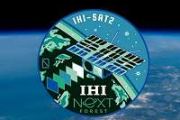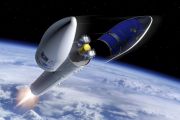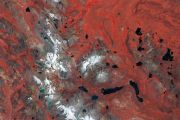
Copernical Team
Space ISAC launches first Global ISAC Hub in Australia
 Space Information Sharing and Analysis Center (Space ISAC) has announced the establishment of its first international Global Hub in Australia. This initiative aims to expand collaboration among Space ISAC members in the region, foster cooperation, and strengthen the sharing of "all threats, all hazards" information to enhance the security of Australian space missions and critical infrastructure.
Space Information Sharing and Analysis Center (Space ISAC) has announced the establishment of its first international Global Hub in Australia. This initiative aims to expand collaboration among Space ISAC members in the region, foster cooperation, and strengthen the sharing of "all threats, all hazards" information to enhance the security of Australian space missions and critical infrastructure. Atomic-6 receives $3.8M to advance space armor shielding
 Atomic-6 has secured a Tactical Funding Increase (TACFI) of $3.8 million to enhance the development of its innovative Space Armor shielding tiles. This funding will support qualification testing and preparation for the technology's first flight deployment.
Space Armor is engineered to address critical challenges in shielding mass, stowage efficiency, post-impact debris, and mission risks.
Atomic-6 has secured a Tactical Funding Increase (TACFI) of $3.8 million to enhance the development of its innovative Space Armor shielding tiles. This funding will support qualification testing and preparation for the technology's first flight deployment.
Space Armor is engineered to address critical challenges in shielding mass, stowage efficiency, post-impact debris, and mission risks. Sidus Space prepares LizzieSat-2 for December launch
 Sidus Space (NASDAQ: SIDU) has finalized launch preparations for LizzieSat-2 at the Astrotech Space Operations facility in Vandenberg Space Force Base, California. The satellite is now in SpaceX's custody, poised for deployment on the Bandwagon-2 rideshare mission, scheduled for December 2024.
LizzieSat-2, built at Sidus Space's cutting-edge Florida Space Coast facility, integrates an adva
Sidus Space (NASDAQ: SIDU) has finalized launch preparations for LizzieSat-2 at the Astrotech Space Operations facility in Vandenberg Space Force Base, California. The satellite is now in SpaceX's custody, poised for deployment on the Bandwagon-2 rideshare mission, scheduled for December 2024.
LizzieSat-2, built at Sidus Space's cutting-edge Florida Space Coast facility, integrates an adva China FAST telescope discovers over 1000 pulsars
 China's Five-hundred-meter Aperture Spherical Radio Telescope (FAST), the largest and most sensitive filled-aperture radio telescope in the world, has identified over 1,000 new pulsars since it began operations, its operator announced on Tuesday.
According to the National Astronomical Observatories under the Chinese Academy of Sciences (NAOC), FAST's pulsar discoveries outnumber those made
China's Five-hundred-meter Aperture Spherical Radio Telescope (FAST), the largest and most sensitive filled-aperture radio telescope in the world, has identified over 1,000 new pulsars since it began operations, its operator announced on Tuesday.
According to the National Astronomical Observatories under the Chinese Academy of Sciences (NAOC), FAST's pulsar discoveries outnumber those made Astronomers identify potential source of mysterious stellar signals
 Researchers at the Curtin University node of the International Centre for Radio Astronomy Research (ICRAR) have made a record-setting discovery while uncovering clues to a rare cosmic phenomenon known as long-period radio transients.
Associate Professor Natasha Hurley-Walker, alongside then-undergraduate Csanad Horvath, identified a unique energy pulse while analyzing archival data from th
Researchers at the Curtin University node of the International Centre for Radio Astronomy Research (ICRAR) have made a record-setting discovery while uncovering clues to a rare cosmic phenomenon known as long-period radio transients.
Associate Professor Natasha Hurley-Walker, alongside then-undergraduate Csanad Horvath, identified a unique energy pulse while analyzing archival data from th Eclipse maker Proba-3 to revolutionize solar corona observations
 The elusive solar corona, a faint, ultra-hot layer of the Sun, has intrigued scientists for centuries. This region, responsible for solar winds and storms, is usually obscured by the Sun's intense light. While natural solar eclipses or specially designed instruments have provided glimpses, ESA's Proba-3 mission is poised to offer unprecedented access through advanced technology.
Proba-3, c
The elusive solar corona, a faint, ultra-hot layer of the Sun, has intrigued scientists for centuries. This region, responsible for solar winds and storms, is usually obscured by the Sun's intense light. While natural solar eclipses or specially designed instruments have provided glimpses, ESA's Proba-3 mission is poised to offer unprecedented access through advanced technology.
Proba-3, c NASA selects NOAA for development of space weather sensors on SWFO-1
 NASA has awarded a $20.5 million cost-plus-fixed-fee contract to Johns Hopkins University's Applied Physics Laboratory (APL) in Laurel, Maryland, for the development of Suprathermal Ion Sensors as part of NOAA's Space Weather Next Program. These sensors will be critical for the Lagrange 1 Series project, providing real-time data to improve space weather forecasting.
The contract, set to co
NASA has awarded a $20.5 million cost-plus-fixed-fee contract to Johns Hopkins University's Applied Physics Laboratory (APL) in Laurel, Maryland, for the development of Suprathermal Ion Sensors as part of NOAA's Space Weather Next Program. These sensors will be critical for the Lagrange 1 Series project, providing real-time data to improve space weather forecasting.
The contract, set to co Final data and undiscovered images from NASA's NEOWISE
 While NASA's NEOWISE telescope ended its journey through space on Nov. 1, 2024, the team at IPAC, a science center at Caltech, was working on one further gift from the prolific mission.
The final data release from NEOWISE was released to the astronomy community just two weeks later, on Nov. 14, encompassing over 26 million images and nearly 200 billion sources detected by the telescope.
While NASA's NEOWISE telescope ended its journey through space on Nov. 1, 2024, the team at IPAC, a science center at Caltech, was working on one further gift from the prolific mission.
The final data release from NEOWISE was released to the astronomy community just two weeks later, on Nov. 14, encompassing over 26 million images and nearly 200 billion sources detected by the telescope. Discovery Alert: a 'Hot Neptune' in a Tight Orbit
 A Neptune-sized planet, TOI-3261 b, makes a scorchingly close orbit around its host star. Only the fourth object of its kind ever found, the planet could reveal clues as to how planets such as these form.
An international team of scientists used the NASA space telescope, TESS (the Transiting Exoplanet Survey Satellite), to discover the exoplanet (a planet outside our solar system), then ma
A Neptune-sized planet, TOI-3261 b, makes a scorchingly close orbit around its host star. Only the fourth object of its kind ever found, the planet could reveal clues as to how planets such as these form.
An international team of scientists used the NASA space telescope, TESS (the Transiting Exoplanet Survey Satellite), to discover the exoplanet (a planet outside our solar system), then ma Team identifies how interstellar medium impacts pulsar signals
 A new study led by Sofia Sheikh of the SETI Institute has revealed how pulsar signals - emissions from the spinning remnants of massive stars - are distorted as they traverse the interstellar medium (ISM). The findings, published in The Astrophysical Journal, were developed through contributions from undergraduate researchers in Penn State's Pulsar Search Collaboratory, a student program origina
A new study led by Sofia Sheikh of the SETI Institute has revealed how pulsar signals - emissions from the spinning remnants of massive stars - are distorted as they traverse the interstellar medium (ISM). The findings, published in The Astrophysical Journal, were developed through contributions from undergraduate researchers in Penn State's Pulsar Search Collaboratory, a student program origina 





























